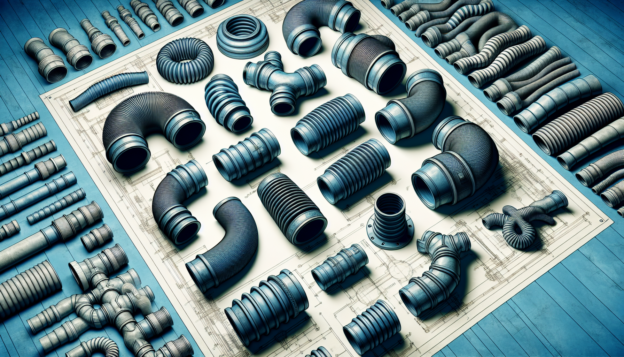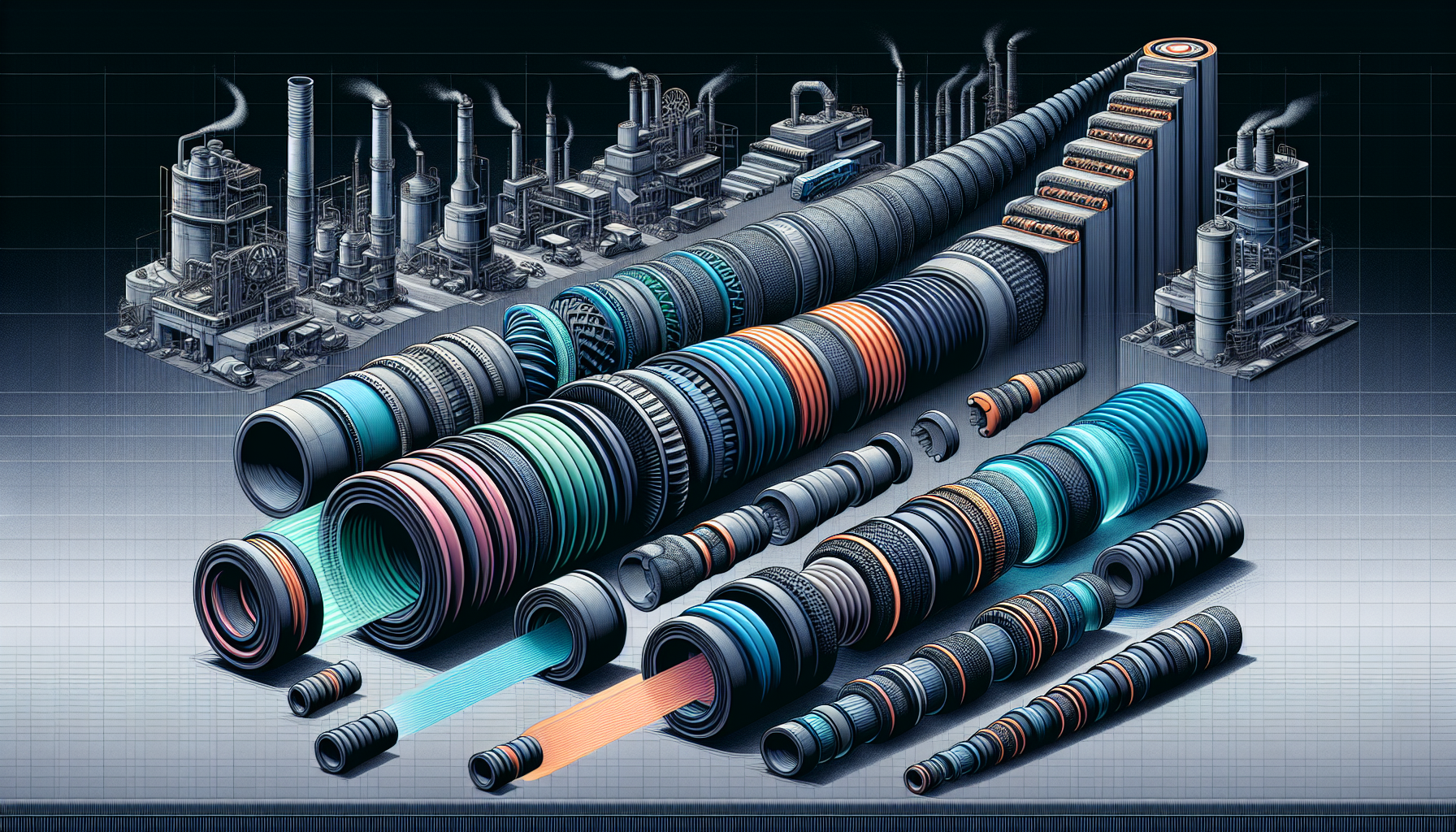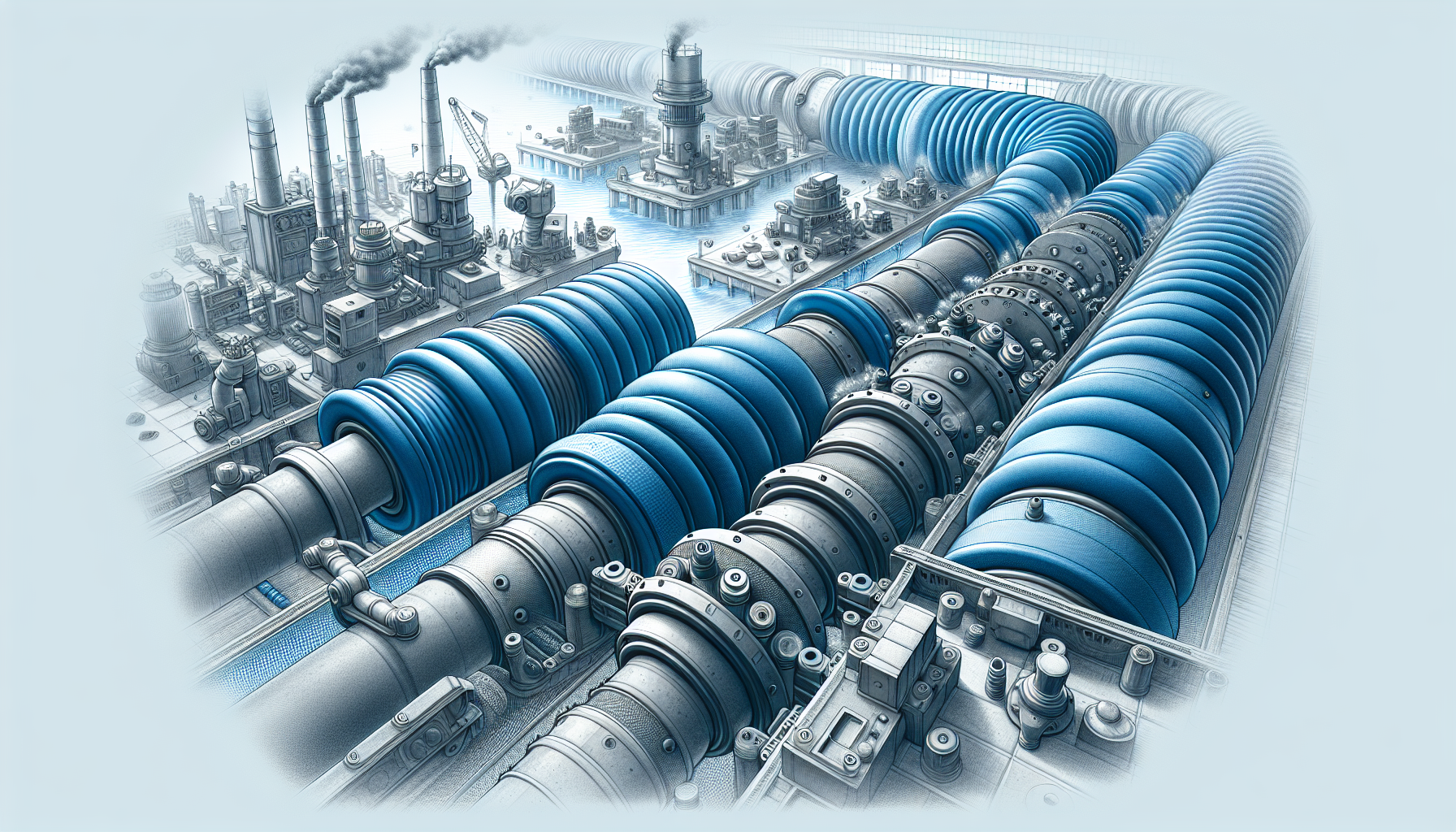Are you looking to understand how rubber duct expansion joints accommodate movement and reduce vibration in piping systems? These essential components, crafted from natural or synthetic rubbers reinforced with fabric, are designed to maintain system integrity under various pressures and temperatures. This article delves into the key functions, types, and benefits of rubber expansion joints, ensuring you have the knowledge to select and maintain the right joints for your industrial needs.
Key Takeaways
- Rubber duct expansion joints serve critical functions such as reducing vibration transmission, accommodating thermal pipe movement, and sustaining various pressures and temperatures, thereby ensuring the smooth operation of fluid-transport systems.
- The design and material composition of rubber expansion joints are crucial for their optimal performance. Innovations in elastomer technology and design features such as wide arches and control units have led to superior durability, enhanced movement capabilities, and better flow capacity.
- Correct installation practices and routine maintenance are essential for the longevity and functionality of rubber expansion joints. Regular inspections can detect wear, misalignment, or excessive movement, reducing the risk of system failure and extending maintenance intervals.
👉Also Read: How Shore Hardness Scales Measure and Determine Polyurethane Properties
Exploring the Essentials of Rubber Duct Expansion Joints
The heart of any fluid-transport system beats with the pulse of its components, the most dynamic of which is the rubber expansion joint. Envision these joints as flexible connectors made of natural or synthetic elastomers, reinforced with special fabrics for added physical strength.
Serving as the most pliable element within a piping system, they create a seal under varying pressures and temperatures while graciously accommodating thermal pipe movement.
Definition and Function
Rubber expansion joints are crafted to counteract the stresses of industrial ballet. They are engineered components that allow duct systems to dance gracefully. Rubber expansion joints have several important functions:
- They reduce vibration transmission from machinery and absorb energy in applications where vibration dampening is crucial.
- They accommodate thermal pipe movement, aiding in both vibration reduction and thermal expansion.
- Types like polyurethane rubber expansion joints make almost no load impact on system components such as dampers and fans.
Rubber expansion joints play a pivotal role in ensuring the smooth operation of duct systems.
Types and Configurations
In the diverse world of industry, rubber expansion joints cater to a spectrum of applications with a variety of configurations, including PTFE lined expansion joints and others such as:
- Concentric reducing
- Tapered
- Tied
- Hinged
- Gimbal
- Pressure balanced
- Elbow
- Flanged
- Threaded
With fabrication methods such as molding for medium-sized joints and automated winding for high-volume production, these joints adapt to square, rectangular, or round shapes to suit different pipework designs.
Material Advantages
The elastomers used in these joints are akin to the muscles of an athlete, stretching and flexing, yet always returning to their original shape after stress is released. Withstanding continuous temperatures up to 194°F, materials like polyurethane and silicone offer sealing properties that make them indispensable across various industrial applications.
Rubber expansion joints have the following benefits:
- They accommodate significant movements and stress
- They resist operational temperature ranges to prevent elasticity loss or brittleness
- They ensure durability and adaptability
Design Parameters for Optimal Performance
The effectiveness of rubber expansion joints hinges on the meticulousness of their design. Available in sizes from a mere inch to an expansive 36 inches, these joints can manage movements with single or multiple arch designs. Yet, without proper anchoring and control units, the stability of these joints could falter, leading to potential system failure – a reminder that even the most flexible components require a solid foundation.
Size and Movement Capabilities
Rubber expansion joints are the epitome of versatility, operating in sizes from ½” up to a colossal 144” to meet the demands of varied duct system requirements. They are the maestros of movement, managing:
- Axial shifts
- Lateral shifts
- Angular shifts
- Torsional shifts
This makes them suitable for scenarios including ground settlement and seismic events.
Arch-type rubber expansion joints, specifically, use an elastomeric arch to accommodate these movements with finesse. For non-standard applications, custom elastomeric expansion joints are crafted to connect pipe flanges spaced at unique distances, enhancing system longevity and functionality.
Pressure and Temperature Factors
When faced with high temperatures and pressures, rubber expansion joints must maintain their pressure resistance, handling substances like steam or exhaust gases with ease. Materials such as EPDM may lose pressure handling capacity at elevated temperatures, raising concerns for long-term reliability. As temperatures rise, pressure capability decreases, making pressure derating an essential factor in system design.
It’s a delicate balance, as larger rubber expansion joints generally have lower pressure tolerances, particularly under fluctuating vacuum conditions or high temperatures, thus aligning joint size with system specifications is paramount.
Installation and Maintenance Insights
In the realm of rubber expansion joints, the adage “well begun is half done” rings particularly true. These components require meticulous handling during installation to prevent damage, avoiding lifting by bolt holes and ensuring they never make contact with the ground.
When placed in specialized environments, such as underground or submerged, it’s essential to consult with manufacturers to prevent exposure to harmful elements, such as welding, that could compromise the joint’s integrity.
Correct Installation Practices
The installation of rubber expansion joints requires precision and attention to detail. Here are some key steps to follow:
- Ensure that the piping is aligned correctly before installing the joints. This will ensure that the rated movements are not compromised and that stress is not induced.
- Tighten the bolts in stages and alternate around the flange. This will create an even seal and prevent misalignment.
- Check that the pressure management is effective and that there are no leaks or issues with the joints.
By following these steps, you can ensure a successful installation of rubber expansion joints.
Close to anchor points, expansion joints must not bear the weight of the pipe, necessitating appropriate supports to ward off undue stress. Orientation tags on custom joints guide correct installation, ensuring safer and more efficient maintenance.
Routine Inspection and Maintenance
Like a well-oiled machine, rubber expansion joints require regular check-ups to spot signs of wear such as settling, misalignment, or excessive movement. Bolt tightness should be monitored, especially after the initial operation and in systems that experience temperature fluctuations. A thin layer of graphite with glycerin or water can be applied to the rubber flanges to aid future removal and seal any cracks or gouges promptly to prevent liquid penetration.
Strategic placement of these joints within the piping system not only facilitates the handling of thermal expansion and contraction but also extends the system’s life and the intervals between maintenance.
👉Also read: Maximize Performance with Urethane Sheet Stock: Unrivaled Abrasion Resistance
Custom Solutions for Unique Challenges
In the world of rubber expansion joints, one size does not fit all. To meet the demands of greater movement capabilities, these joints can be tailored with:
- Multiple arches
- Extended dimensions
- Multiple convolutions
- Built-in angle and lateral offsets
With these features, rubber expansion joints can skillfully handle large displacements and diminish stress.
The bespoke nature of these expansion joints means they can be manufactured to meet the exacting requirements of unique applications.
Case Studies: Tailored Applications
From power plants to the realms of steel, iron, aluminum, chemical, food, and drinking water industries, custom rubber expansion joints provide solutions that are as varied as the challenges they face. Aging facilities, grappling with the effects of thermal cycling, vibration, and foundation settling, find solace in these joints, ensuring the alignment of their piping and pumps remains intact.
For systems with unique misalignments, including lateral and angular offsets, custom-sized joints are designed to ensure flanges stay connected despite non-parallel or uncentered alignments.
The Role of Rubber Expansion Joints in System Safety
At their core, rubber expansion joints are guardians of system safety, absorbing shock, vibration, and thermal energy to protect the integrity of piping systems. Their presence is a testament to the importance of maintaining equilibrium in the face of dynamic forces that could otherwise compromise the stability of intricate networks.
Vibration Reduction and Noise Dampening
When mechanical equipment roars to life, rubber expansion joints are there to:
- Soften the sound
- Absorb vibrations and noises
- Mitigate stresses such as misalignment and temperature-induced expansions
- Isolate equipment to prevent structure-borne noise
Ultra-Sphere flexible connector, with their superior ability to absorb noise and vibration, offer a marked improvement over braided metal connectors, reaffirming rubber’s unparalleled ability to reduce sound transmission.
Protecting Against Overpressure and Misalignment
In scenarios where misalignment and overpressure loom as potential threats, rubber expansion joints stand as bulwarks, ensuring system durability and safety. Designed to dampen vibrations and resist hydraulic surges, they are the cushion that softens the blow of disturbances and prevent damage to the system.
Technological Advancements in Elastomer Technology
As we journey further into the intricacies of rubber expansion joints, we find that technological advancements in elastomer technology have led to the creation of materials that are not just robust but revolutionary. With enhanced biocompatibility, electrical insulation properties, and resistance to extreme conditions, silicone elastomers have expanded their reign across industries. New processing methods such as molding, extrusion, and casting have propelled the manufacturing capabilities into a new era.
Polyurethane elastomers, famed for their abrasion resistance, have seen innovations that render them ideal for high-stress applications. Polyester urethane, with its superior sliding abrasion resistance and tensile strength, has become a stalwart in roles like scraper blades, while polyether polyurethane shines in situations where lubrication is minimal. Each material, with its distinct properties, finds its niche, with polyester urethane showing resilience against oils and chemicals, as well as rubbing abrasion, albeit with a caveat in humid environments. The urethane surface of these materials contributes to their overall performance and durability.
Innovations in Material Composition
The evolution of material composition for rubber expansion joints is marked by the addition of layers that augment tensile strength, durability, and tear resistance. Teflon, for its exceptional chemical resistance, has become a valuable ally in the manufacturing process. Fiberglass, too, plays a role, serving as an insulation layer that fortifies the joints against the rigors of industrial environments.
Enhanced Design Features
Innovation does not stop at materials; it extends to design features as well. Wide arch designs have emerged, increasing movement capabilities and reducing turbulence for improved flow capacity within the joint. Control units, used alongside expansion joints, regulate movement and enhance stability, preventing overextension and damage under high-pressure conditions.
These design enhancements, including wide arches and control units, not only lengthen the functional lifespan of rubber duct expansion joints but also enable them to better adapt to complex geometries and mitigate the risks associated with misalignment, thermal expansion, and dynamic heat build-up in piping systems.
👉Also Read: Find the Best Customized Urethane Products — Shop Uniflex
Elevate Your Projects with Uniflex, Inc.’s Polyurethane Rubber Expansion Joints!
Step into the world of Uniflex’, Inc.’s Polyurethane Rubber Expansion Joints, where state-of-the-art polyurethane material meets innovative design to deliver joints that redefine industry standards. With minimal load impact on critical interfacing flanges, a diverse range of materials for corrosion and high-temperature resistance, and superior durability, these expansion joints are a testament to Uniflex, Inc.’s commitment to excellence.
The elasticity and adaptability of polyurethane in these joints enable them to accommodate movement and vibration, safeguarding structural integrity and ensuring longevity in demanding industrial applications.
Contact us today to discover how Uniflex, Inc.’s Polyurethane Rubber Expansion Joints can enhance the performance and longevity of your industrial applications.







